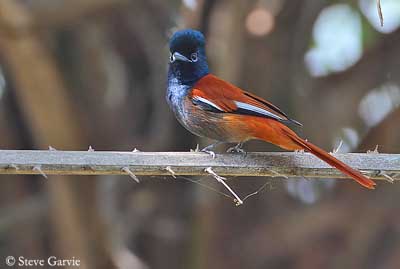
African Paradise-Flycatcher
Terpsiphone viridis
Passeriforme Order – Monarchidae Family
BIOMETRICS :
Length: 16-18 cm. Breeding male is about 28-35 cm with the tail.
Weight: M: 13-14 g – F: 12-13 g
DESCRIPTION:
African Paradise-Flycatcher is a beautiful bird with very long tail which allows sometimes detecting the bird among the foliage.
Plumage is very variable, from rufous to white, with five colours recognized.
Adult male (of all types) has rufous upperparts, upperwing and tail, with variable amount of black and white and greyish underparts.
Head is glossy blue-black with a crest. Central tail feathers are very elongated. In breeding plumage, the upper mandible and the eye-rings become electric-blue.
The male of nominate race has deep rufous upperparts. Wings show conspicuous white edgings.
Underparts are glossy blue-black on throat and breast. Belly is duller, mostly dark grey. Undertail coverts and tail are rufous.
Head is glossy blue-black with dark, thick crest on the crown.
Bill is cobalt-blue with black tip. Eyes are dark brown with thick bright cobalt-blue eye-ring. Legs and feet are bluish-black.
Fr: Tchitrec d’Afrique
All : Graubrust-Paradiesschnäpper
Esp: Monarca Paraíso Africano
Ital: Pigliamosche del Paradiso africano
Nd: Afrikaanse Paradijsmonarch
Sd: Afrikansk paradisflugsnappare
Photographers :
Steve Garvie
RAINBIRDER Photo galleries
Callie de Wet
GALLERY
Text by Nicole Bouglouan
Sources:
HANDBOOK OF THE BIRDS OF THE WORLD Vol 11 by Josep del Hoyo, Andrew Elliott and David Christie - Lynx Edicions - ISBN: 849655306X
BIRDS OF THE GAMBIA AND SENEGAL by Clive Barlow and Tim Wacher – Helm Field guides – ISBN: 0713675497
BIRDS OF AFRICA SOUTH OF THE SAHARA by Ian Sinclair and Peter Ryan - Princeton University Press Princeton and Oxford - ISBN: 0691118159
L’ENCYCLOPEDIE MONDIALE DES OISEAUX - Dr Christopher M. Perrins - BORDAS - ISBN: 2040185607

Female is similar with shorter crest. She lacks the elongated tail feathers. Her plumage is duller, less glossy, with browner tinge instead of deep rufous, and paler grey underparts.
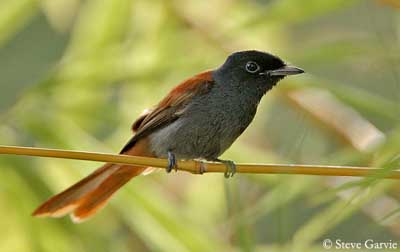
Immature resembles female but it lacks or has very short crest.
Juvenile is duller than immature. It has dark brown head, browner upperparts and greyish-brown to pale brown-rufous underparts.
We find ten subspecies sharing the sub-Saharan range. They differ in plumage pattern and intensity of colours.
The race T.v. plumbeiceps displayed below has dark head, rufous upperparts and tail, white or pale rusty-white underparts. It lacks the white edgings on the wings.
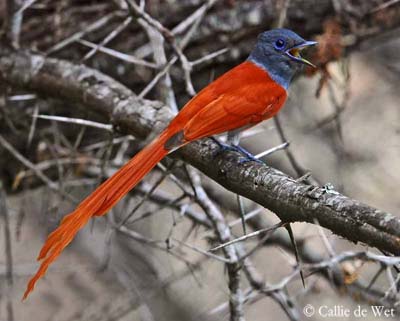
We find five colour types, with various upperparts colours and patterns.
The bird displayed here is “colour type 5”. It has white entire upperparts, including upperwing coverts and broad edgings in secondaries and tertials. Primaries are mostly black. The tail shows very elongated white central rectrices (5 to 12 cm beyond the other feathers). Belly, flanks and undertail coverts are dark slate-grey. Bill and eye-ring are paler than in other birds, mostly pale blue-grey.
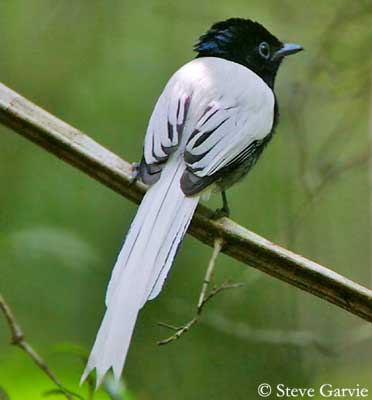
VOICE: SOUNDS BY XENO-CANTO
African Paradise-Flycatcher is a noisy bird. Contact call is a simple “zeet, zwayt” in South Africa, “ti-twit-tee-twit” in Gabon, and “zi,zk-zk” in Tanzania.
These harsh calls often indicate its presence.
The territorial male has varied songs, with individual and local variations. It usually gives a loud, rippling phrase “twee-twee-twee-twee…” often repeated and almost continuously.
This song varies according to the range.
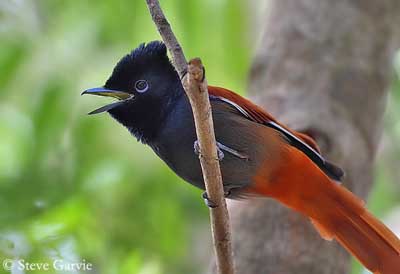
HABITAT:
African Paradise-Flycatcher frequents mainly dense habitats, but avoids heavy forest and dry thorn-scrub. It may be seen in open forest and plantations, bushlands, open woodlands of all types, cultivated fields, edges and clearing of moist forests.
It also frequents gardens and orchards, and may be seen in large trees in and around villages and towns. It is visible from lowlands to mountains, up to 1450 metres of elevation (2500 metres in Kenya).
RANGE:
African Paradise-Flycatcher is found in Africa, south of the Sahara and southwards to South Africa except in south-western parts.
BEHAVIOUR:
African Paradise-Flycatcher is primarily insectivorous, taking insects and spiders. It also consumes small berries.
It feeds on various insects and their eggs and larvae. Preys are about 10 mm long.
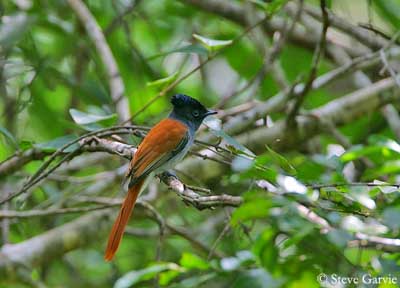
It hunts by hawking from perches, performing quick sallies, or by hovering flight. It also snatches the preys while moving into the foliage, hopping from branch to branch. It reaches the invertebrates hidden on the underside of leaves by short looping or hovering flight. It also moves among the leaves like a butterfly and twists around to catch the flushed insects.
It is able to forage in horizontal position with the tail slightly fanned and partly open and dropping wings. Then, it moves sideways and up and down, and catches the disturbed insects.
African Paradise-Flycatcher feeds mostly inside the canopy.
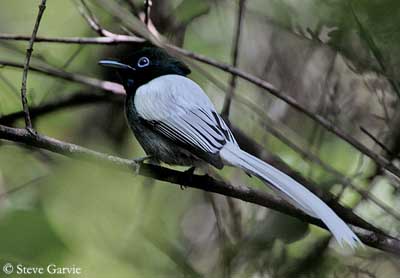
The male performs courtship displays, approaching the female in undulating flight, in order to display the colours of the upperparts and the elongated tail streamers.
Then, it perches in upright stance with sleeked plumage and erect crest. It sweeps the tail and quivers the wing tips. During these displays, the male calls with the bill widely open to expose the bright colours of its mouth. It may also dance on the perch.
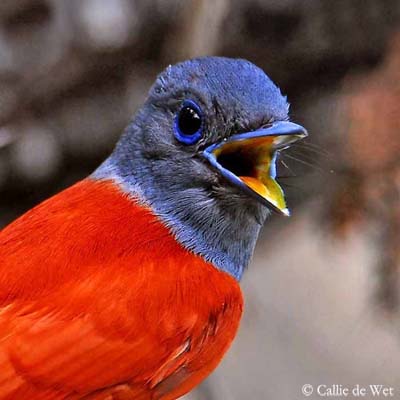
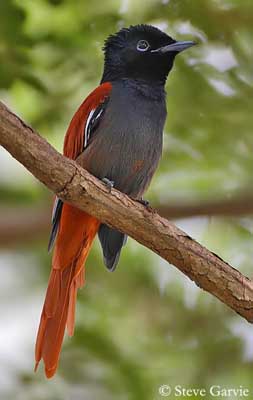
Finally, it crouches with dropped wings and fanned, raised tail, while it quivers the wings and calls softly.
The receptive female observes these displays and both birds lean towards each other.
The male may court several females during pair formation.
African Paradise-Flycatcher seems to be intra-African migrant. Some races perform local movements and others are resident such as T.v. harterti, the Arabian race. We can observe post-breeding migration in the race T.v. plumbeiceps of South Africa.
They return to their breeding areas during the rainy season.
FLIGHT:
African Paradise-Flycatcher performs swift and undulating flight during which the long floating tail-streamers wave gracefully and follow the flight pattern.
REPRODUCTION:
Breeding season may vary according to the range, but occurs during the rains.
The birds are territorial and the singing male defends the area, but if several nests are close to each other, they defend the territory communally.
African Paradise-Flycatcher is monogamous and pair-bonds lacks about one breeding season.
The nest is a lovely structure, a shallow open cup made by both sexes with plant fibres, rootlets, fine pieces of bark and dried leaves, and covered with spider web and lichens. The interior is lined with horsehair or dry grass. The rim is stiff, made with strong fibres. The nest materials depend on the availability in the surroundings of the nest-site.
The nest is placed between 2 and 10 metres above the ground, on exposed fork or in cluster of dead twigs at the end of a branch.
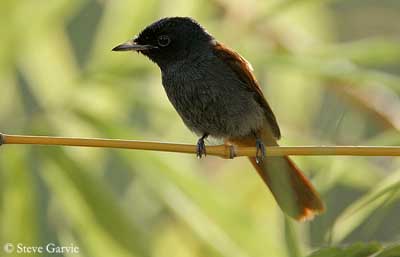
Female lays 2-5 eggs. Incubation lasts about 13-15 days, shared by both adults. Chicks are fed by parents and fledge between 11 and 16 days after hatching, according to the range. Young depends on adults for one week more after fledging.
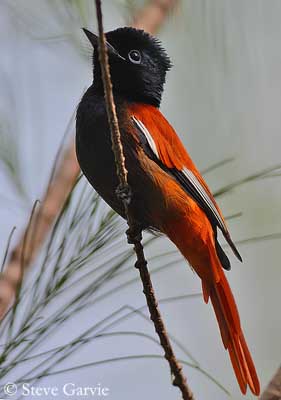
DIET:
African Paradise-Flycatcher feeds mainly on insects such as beetles, hymenopterans, dipterans, cicadas, moths and butterflies, mantids, swarms of flying termites and ants. It also takes spiders and consumes small berries.
PROTECTION/THREATS/ STATUS:
African Paradise-Flycatcher is common to locally abundant and widespread. This species is not threatened at this moment.